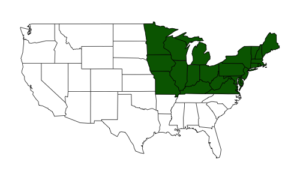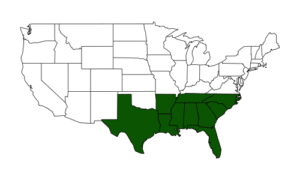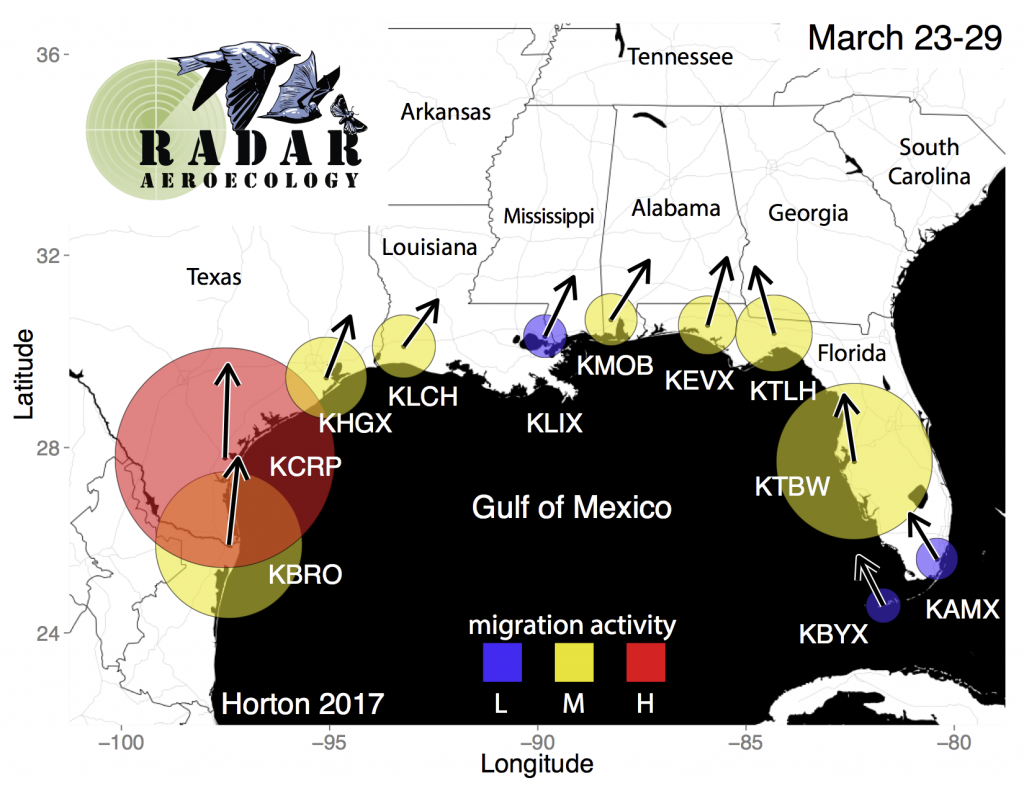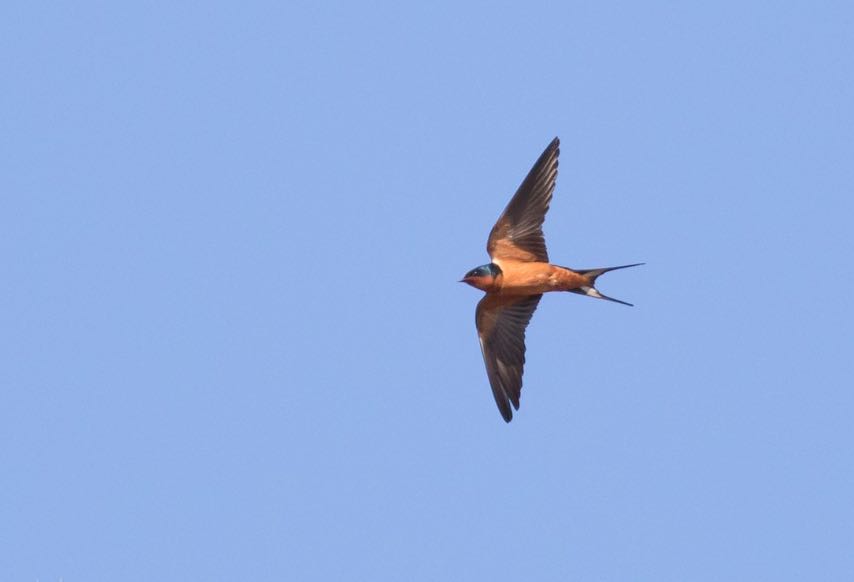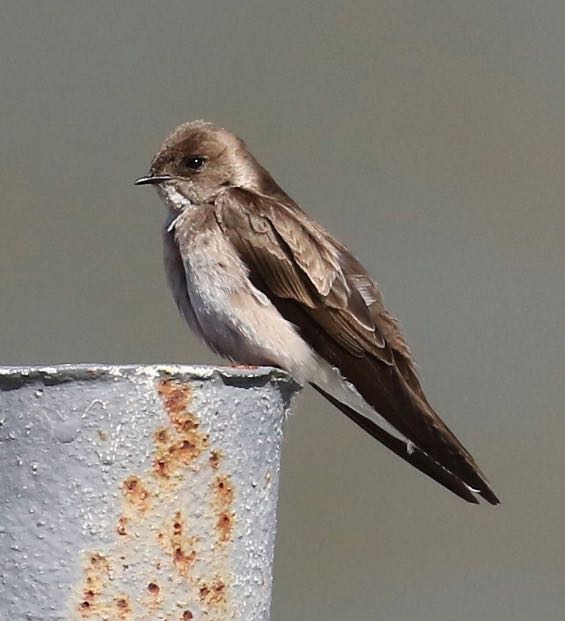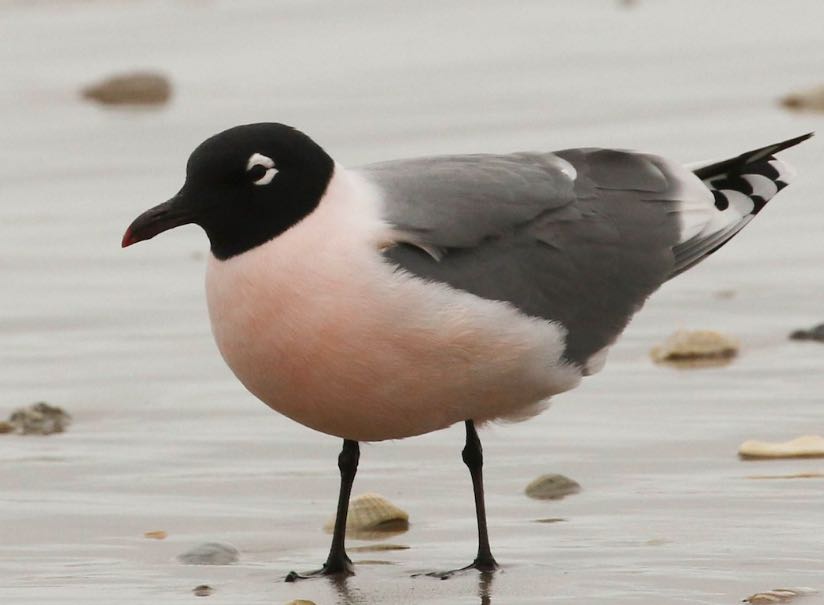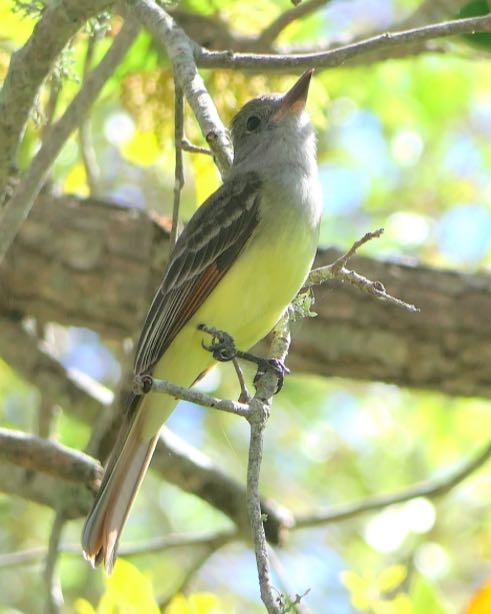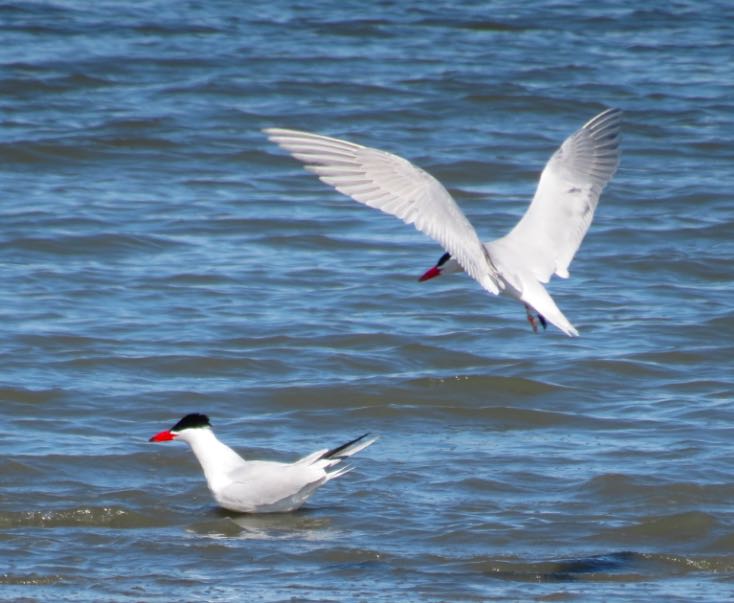Barn Swallow. Tom Johnson/Macaulay Library. eBird S35357293.
Continental Summary
The West will see a mix of marginal migration conditions spawning scattered light to moderate movements featuring Caspian Tern, Cassin’s Vireo, Barn Swallow, American Pipit, Black-throated Gray Warbler, Savannah Sparrow, and Golden-crowned Sparrow, while light to locally heavy flights in the first half of the period and to end the period in the East will feature Sharp-shinned Hawk, Franklin’s Gull, Northern Rough-winged Swallow, Great Crested Flycatcher, Pine Warbler, Yellow-throated Warbler, Yellow-headed Blackbird, Orchard Oriole, and Field Sparrow. The forecast for late in this period also suggests the first significant chance for fallouts and concentrations of migrants along the Gulf Coast.
Arrows show wind speed and direction (arrow points in the direction to which wind is blowing) 100 m above ground level. Areas with southerly winds are colored red; northerly winds colored blue. Accumulated precipitation (in 6 hour intervals) is green, outlined by white. Broadly speaking, areas of the map in red will experience conditions that are favorable for migration, and areas where red and green (and red and blue) intersect and overlap may experience migrant concentrations and fallouts as migrants interact with precipitation.
We use data collected by eBird users help make more accurate forecasts. If you enjoy the predictions contained in these posts, please consider submitting your own bird sightings to eBird to even further improve the content. Every observation counts, whether it be a single bird at a feeder in your backyard, or an entire day spent in a national park. To get started with eBird, head on over to the site !
Please note that photographs and other digital media showing birds come from the Macaulay Library , which receives credit along with the photographer/observer in the media caption as part of a new initiative that allows public contribution, access and use of natural history media .
Finally, and new for Spring 2017 , our friend Kyle Horton of the Radar Aeroecology Lab at Oklahoma University created a new set of images depicting spring bird movements in the Gulf of Mexico region as part of an analysis that he is leading as part of our ongoing collaboration. This feature appears in the Gulf Coast and Southeast region forecast.
Need a review of our definitions for regions, species on the move, and migration amounts? Please visit this link .
Quick Links to Regions
Upper Midwest and Northeast
Favorable migration conditions kick off the weekend for much of the region away from the Great Lakes, and moderate to locally heavy flights are likely to be widespread. Birders in the Northeast should watch for concentrations of migrants on Saturday morning where precipitation and migrants over, particularly from Lakes Erie and Ontario east to the Atlantic Coast. A similar though less extensive pattern of this patchwork of precipitation and favorable migration conditions will continue around the region through Tuesday, and mostly moderate to locally heavy flights will also continue. As low pressure gets organized and moves out of the Plains and through the Northeast, much less favorable conditions arrive. Tuesday night will see a significantly less extensive and less intense set of movements, mostly along the coast. These cooler and less favorable conditions remain through the remainder of the period, with southerly flow and moderate flights returning by Friday night.
Northern Rough-winged Swallow. Sherrie Quillen/Macaulay Library. eBird S35360424.
Species on the Move
Species
Noticeability
Migrants Begin Arriving
Rapid Migrant Influx
Peak
Rapid Migrant Departure
Last Migrants Depart
Purple Finch
*
2/2
4/12
4/25
5/7
5/16
Northern Harrier
*
2/20
3/30
4/8
4/23
5/5
American Kestrel
**
2/26
3/30
4/12
4/28
5/11
Wilson's Snipe
**
3/7
3/29
4/14
5/1
5/12
Cooper's Hawk
*
3/11
4/13
4/24
5/13
5/25
Osprey
***
3/13
3/30
4/18
5/1
5/11
Brown-headed Cowbird
****!
3/14
4/8
5/2
5/17
After Jun 30
Blue-winged Teal
***
3/15
4/1
4/18
5/3
5/16
Pectoral Sandpiper
**
3/17
3/29
4/16
5/23
6/5
Tree Swallow
****!
3/17
4/1
5/9
5/25
After Jun 30
Bonaparte's Gull
***
3/18
3/28
4/11
4/24
5/4
Double-crested Cormorant
***
3/19
3/31
4/19
6/1
6/11
Great Egret
***
3/19
3/30
5/14
5/27
6/4
Common Loon
***
3/20
3/30
4/11
4/23
5/2
Golden-crowned Kinglet
***
3/20
3/28
4/8
4/21
4/30
Laughing Gull
**
3/20
4/2
5/17
5/30
6/7
Brown Creeper
***
3/21
3/30
4/10
4/25
5/6
Northern Flicker
****!
3/22
4/4
4/21
5/6
5/18
Winter Wren
**
3/22
3/31
4/14
4/27
5/8
Black-crowned Night-Heron
*
3/23
5/3
5/21
5/28
6/2
Greater Yellowlegs
***
3/23
4/9
4/27
5/16
6/1
Yellow-bellied Sapsucker
***
3/23
4/1
4/13
4/25
5/3
Vesper Sparrow
**
3/23
4/2
6/14
After Jun 30
-
Belted Kingfisher
***
3/24
4/4
4/19
5/5
5/20
Snowy Egret
**
3/24
4/3
5/22
6/2
6/9
Purple Martin
***
3/25
4/9
5/18
6/1
6/10
Forster's Tern
**
3/26
4/25
5/10
5/25
6/4
Forster's Tern
**
3/26
4/25
5/10
5/25
6/4
Glossy Ibis
*
3/26
4/6
5/25
6/3
6/9
Pine Warbler
***
3/27
4/9
4/25
5/8
5/18
Field Sparrow
***
3/28
4/11
4/27
5/7
5/14
Merlin
*
3/29
4/8
4/23
5/24
6/7
Hermit Thrush
***
3/29
4/8
4/22
5/4
5/13
Yellow-throated Warbler
***
3/29
4/9
4/24
5/7
5/17
Sharp-shinned Hawk
*
3/30
4/10
4/21
5/9
5/22
Northern Rough-winged Swallow
***
3/31
4/14
5/3
5/17
6/2
Brown Thrasher
***
4/1
4/13
4/30
5/11
5/20
Chipping Sparrow
****!
4/1
4/14
5/2
5/13
5/22
Savannah Sparrow
***
4/1
4/14
5/4
5/16
5/25
Virginia Rail
*
4/2
4/16
5/6
5/21
After Jun 30
Ruby-crowned Kinglet
****!
4/2
4/12
4/25
5/8
5/19
American Bittern
*
4/2
4/15
5/6
After Jun 30
-
Lesser Yellowlegs
***
4/3
4/20
5/4
5/20
5/30
Peaking Arrivals
Species
Noticeability
Migrants Begin Arriving
Rapid Migrant Influx
Peak
Rapid Migrant Departure
Last Migrants Depart
Bufflehead
***
2/21
3/2
3/28
4/21
5/6
Ruddy Duck
*
2/21
3/2
4/1
4/25
5/10
American Coot
**
2/21
3/3
4/6
5/1
5/21
Red-winged Blackbird
***
2/18
3/3
5/5
5/20
After Jun 30
Northern Shoveler
***
2/20
3/5
4/4
4/26
5/11
Killdeer
***
2/20
3/6
3/30
6/3
6/13
Common Grackle
***
2/19
3/6
5/14
6/6
After Jun 30
Green-winged Teal
***
2/20
3/7
3/31
4/24
5/10
Rusty Blackbird
*
2/23
3/8
4/10
5/1
5/13
Horned Grebe
**
2/26
3/9
3/27
4/17
5/7
Great Blue Heron
***
3/2
3/21
5/14
5/28
6/7
Fox Sparrow
***
3/1
3/21
4/2
4/19
4/29
Pied-billed Grebe
***
3/3
3/25
4/9
4/27
5/12
Eastern Phoebe
***
3/12
3/26
4/13
5/27
6/6
Northern Gannet
*
3/17
3/26
4/6
4/19
4/28
Bonaparte's Gull
**
3/18
3/28
4/11
4/24
5/4
Golden-crowned Kinglet
***
3/20
3/28
4/8
4/21
4/30
Pectoral Sandpiper
*
3/17
3/29
4/16
5/23
6/5
Wilson's Snipe
**
3/7
3/29
4/14
5/1
5/12
Common Loon
***
3/20
3/30
4/11
4/23
5/2
Northern Harrier
*
2/20
3/30
4/8
4/23
5/5
American Kestrel
**
2/26
3/30
4/12
4/28
5/11
Brown Creeper
***
3/21
3/30
4/10
4/25
5/6
Great Egret
***
3/19
3/30
5/14
5/27
6/4
Osprey
***
3/13
3/30
4/18
5/1
5/11
Double-crested Cormorant
***
3/19
3/31
4/19
6/1
6/11
Winter Wren
**
3/22
3/31
4/14
4/27
5/8
Blue-winged Teal
***
3/15
4/1
4/18
5/3
5/16
Yellow-bellied Sapsucker
***
3/23
4/1
4/13
4/25
5/3
Tree Swallow
***
3/17
4/1
5/9
5/25
After Jun 30
Vesper Sparrow
*
3/23
4/2
6/14
After Jun 30
-
Laughing Gull
**
3/20
4/2
5/17
5/30
6/7
Snowy Egret
*
3/24
4/3
5/22
6/2
6/9
Beginning Departures
Species
Noticeability
Migrants Begin Arriving
Rapid Migrant Influx
Peak
Rapid Migrant Departure
Last Migrants Depart
American Tree Sparrow
***
-
-
Before Feb 1
4/18
5/4
Dark-eyed Junco
***
-
2/2
2/15
4/22
5/6
Brant
*
2/19
2/24
3/4
5/26
6/4
Surf Scoter
*
2/23
2/27
3/5
4/19
4/28
Red-throated Loon
*
2/21
2/26
3/7
4/20
4/30
Greater Scaup
**
2/20
2/27
3/9
4/18
4/30
Herring Gull
***
2/21
2/27
3/9
4/18
6/6
American Black Duck
***
2/20
2/26
3/10
4/16
4/26
Bald Eagle
*
2/19
2/26
3/10
5/26
6/7
Northern Pintail
**
2/16
2/26
3/11
3/27
4/22
Canvasback
**
2/19
2/27
3/11
3/27
4/25
Tundra Swan
**
2/19
2/27
3/12
3/30
4/17
Redhead
**
2/19
2/27
3/12
3/27
4/28
Common Merganser
***
2/19
2/27
3/12
4/16
4/29
Ring-billed Gull
***
2/20
2/27
3/13
4/18
4/28
Red-breasted Merganser
**
2/20
2/27
3/14
4/21
5/5
American Wigeon
***
2/17
2/27
3/16
4/14
4/28
Gadwall
**
2/19
2/28
3/17
4/18
5/2
Hooded Merganser
***
2/20
3/2
3/18
4/8
4/24
Lesser Scaup
***
2/19
3/1
3/21
4/18
5/5
American Woodcock
*
2/20
3/3
3/21
4/6
6/3
Ring-necked Duck
***
2/20
3/3
3/23
4/16
5/1
Horned Grebe
***
2/26
3/9
3/27
4/17
5/7
Bufflehead
***
2/21
3/2
3/28
4/21
5/6
Killdeer
*
2/20
3/6
3/30
6/3
6/13
Green-winged Teal
***
2/20
3/7
3/31
4/24
5/10
Ruddy Duck
**
2/21
3/2
4/1
4/25
5/10
Fox Sparrow
***
3/1
3/21
4/2
4/19
4/29
Ending Departures
Species
Noticeability
Migrants Begin Arriving
Rapid Migrant Influx
Peak
Rapid Migrant Departure
Last Migrants Depart
Common Redpoll
*
-
2/2
2/15
3/9
5/2
Snow Bunting
*
-
-
Before Feb 1
3/10
4/5
Black Scoter
*
2/23
2/27
3/5
3/18
6/1
Long-tailed Duck
*
2/22
2/26
3/5
3/18
4/26
Horned Lark
*
2/17
2/24
3/6
3/20
After Jun 30
Great Cormorant
*
2/24
2/27
3/4
3/20
4/24
Rough-legged Hawk
*
2/21
2/26
3/5
3/21
4/9
Common Goldeneye
***
2/20
2/26
3/8
3/24
4/23
Snow Goose
**
2/15
2/25
3/9
3/26
4/13
Northern Pintail
***
2/16
2/26
3/11
3/27
4/22
Canvasback
**
2/19
2/27
3/11
3/27
4/25
Redhead
**
2/19
2/27
3/12
3/27
4/28
Tundra Swan
**
2/19
2/27
3/12
3/30
4/17
Great Plains
Scattered moderate flights will highlight the weekend, as low pressure passing and several disturbances around the region will make favorable migration conditions more local than widespread. As these pass, cooler air and northerly flow arrive, and migration will be generally light in these conditions to begin the work week. These conditions improve slightly during the remainder of the period, with another low pressure system moving through the southern Plains, but these conditions never become widespread. So migration will likely be scattered and light to locally moderate, especially in the northern and parts of the southern Plains.
Franklin’s Gull. Susan Strasevicz/Macaulay Library. eBird S35128417.
Species
Noticeability
Migrants Begin Arriving
Rapid Migrant Influx
Peak
Rapid Migrant Departure
Last Migrants Depart
Cinnamon Teal
*
2/19
4/5
4/18
5/4
5/16
American White Pelican
***
2/21
3/31
4/13
After Jun 30
-
Horned Grebe
**
2/23
4/1
4/16
5/5
5/17
American Coot
***
2/25
4/2
4/18
5/7
5/22
Wilson's Snipe
**
2/27
3/31
4/15
After Jun 30
-
Field Sparrow
***
3/10
4/2
4/26
5/9
5/17
Blue-winged Teal
****!
3/11
3/29
4/21
5/12
After Jun 30
Turkey Vulture
****!
3/14
3/27
4/17
5/23
After Jun 30
Brown-headed Cowbird
****!
3/16
4/15
5/15
5/23
After Jun 30
Double-crested Cormorant
****!
3/17
3/29
4/14
5/1
After Jun 30
Purple Martin
***
3/19
4/7
5/9
After Jun 30
-
Tree Swallow
***
3/20
4/5
5/5
After Jun 30
-
Ruby-crowned Kinglet
***
3/21
4/1
4/25
5/17
5/27
Vesper Sparrow
***
3/21
4/2
4/19
5/6
After Jun 30
Pied-billed Grebe
***
3/22
4/3
4/17
5/3
5/16
Eastern Towhee
**
3/22
4/28
5/9
5/23
5/31
Great Egret
***
3/23
4/6
4/25
5/8
After Jun 30
Say's Phoebe
*
3/25
4/12
6/11
After Jun 30
-
Eared Grebe
***
3/26
4/13
4/28
5/11
After Jun 30
Sharp-shinned Hawk
*
3/26
4/1
4/8
4/26
5/10
Hermit Thrush
**
3/26
4/7
4/21
5/9
5/21
Bonaparte's Gull
***
3/27
4/5
4/18
5/3
5/14
Savannah Sparrow
***
3/27
4/11
4/25
5/12
After Jun 30
Franklin's Gull
***
3/28
4/8
4/23
5/7
5/18
Lesser Yellowlegs
***
3/29
4/12
4/27
5/13
5/28
Northern Rough-winged Swallow
***
3/30
4/16
5/6
5/21
6/1
Yellow-headed Blackbird
***
3/30
4/11
6/12
After Jun 30
-
Western Grebe
**
3/31
4/17
6/10
After Jun 30
-
American Bittern
**
3/31
4/14
6/11
After Jun 30
-
Snowy Egret
***
4/1
4/12
4/28
5/9
After Jun 30
Osprey
***
4/1
4/11
4/23
5/6
5/15
American Avocet
***
4/1
4/14
5/1
After Jun 30
-
Barn Swallow
****!
4/2
4/20
5/22
After Jun 30
-
Chipping Sparrow
****!
4/2
4/22
5/7
5/21
5/30
Peaking Arrivals
Species
Noticeability
Migrants Begin Arriving
Rapid Migrant Influx
Peak
Rapid Migrant Departure
Last Migrants Depart
Lesser Scaup
***
2/18
3/2
3/31
4/20
After Jun 30
Green-winged Teal
***
2/18
3/6
3/29
4/21
5/12
Killdeer
****!
2/20
3/6
4/1
5/1
After Jun 30
American Pipit
*
2/21
3/6
4/19
5/7
5/19
Ruddy Duck
***
2/26
3/14
4/8
After Jun 30
-
Song Sparrow
***
3/1
3/16
4/1
4/15
4/25
Common Grackle
***
3/2
3/16
5/24
6/10
6/24
Northern Shoveler
***
2/25
3/19
4/13
5/7
After Jun 30
Common Loon
*
3/13
3/24
4/9
5/9
After Jun 30
Greater Yellowlegs
***
3/5
3/25
4/15
5/4
5/18
Wood Duck
**
2/27
3/26
5/7
5/25
6/5
Great Blue Heron
***
2/28
3/26
4/24
5/19
After Jun 30
Baird's Sandpiper
***
3/10
3/26
4/22
5/18
6/4
Turkey Vulture
****!
3/14
3/27
4/17
5/23
After Jun 30
Blue-winged Teal
****!
3/11
3/29
4/21
5/12
After Jun 30
Double-crested Cormorant
***
3/17
3/29
4/14
5/1
After Jun 30
American White Pelican
***
2/21
3/31
4/13
After Jun 30
-
Wilson's Snipe
**
2/27
3/31
4/15
After Jun 30
-
Horned Grebe
*
2/23
4/1
4/16
5/5
5/17
Sharp-shinned Hawk
*
3/26
4/1
4/8
4/26
5/10
Ruby-crowned Kinglet
***
3/21
4/1
4/25
5/17
5/27
American Coot
***
2/25
4/2
4/18
5/7
5/22
Field Sparrow
***
3/10
4/2
4/26
5/9
5/17
Vesper Sparrow
***
3/21
4/2
4/19
5/6
After Jun 30
Pied-billed Grebe
***
3/22
4/3
4/17
5/3
5/16
Beginning Departures
Species
Noticeability
Migrants Begin Arriving
Rapid Migrant Influx
Peak
Rapid Migrant Departure
Last Migrants Depart
Brown Creeper
*
-
-
Before Feb 1
4/18
5/11
Dark-eyed Junco
***
-
2/2
2/10
4/10
4/24
Northern Pintail
**
2/15
2/24
3/11
After Jun 30
-
Redhead
***
2/15
2/26
3/13
3/27
After Jun 30
Northern Harrier
***
2/20
2/27
3/13
4/22
After Jun 30
Golden-crowned Kinglet
*
2/23
2/28
3/13
4/15
4/25
Ring-necked Duck
***
2/15
2/27
3/15
4/6
5/10
Sandhill Crane
***
2/20
3/3
3/18
4/3
4/17
Bufflehead
***
2/20
3/3
3/21
4/13
5/10
Red-breasted Merganser
*
2/22
3/6
3/21
4/11
4/27
Fox Sparrow
**
3/1
3/9
3/23
4/15
4/29
American Wigeon
***
2/16
3/1
3/24
4/20
After Jun 30
Gadwall
***
2/18
2/28
3/26
After Jun 30
-
Green-winged Teal
***
2/18
3/6
3/29
4/21
5/12
Lesser Scaup
***
2/18
3/2
3/31
4/20
After Jun 30
Killdeer
**
2/20
3/6
4/1
5/1
After Jun 30
Song Sparrow
***
3/1
3/16
4/1
4/15
4/25
Ending Departures
Species
Noticeability
Migrants Begin Arriving
Rapid Migrant Influx
Peak
Rapid Migrant Departure
Last Migrants Depart
Hooded Merganser
***
2/20
2/25
3/5
3/17
4/27
Rusty Blackbird
*
2/17
2/23
3/3
3/17
4/21
Cackling Goose
***
2/19
2/25
3/5
3/19
3/31
Common Goldeneye
***
2/19
2/25
3/5
3/19
3/31
Bald Eagle
***
2/19
2/24
3/5
3/19
3/30
Greater White-fronted Goose
***
2/17
2/24
3/8
3/20
3/30
Ross's Goose
***
2/16
2/24
3/7
3/20
3/29
Lapland Longspur
**
2/24
2/27
3/6
3/20
3/31
Common Merganser
***
2/18
2/25
3/6
3/21
4/6
Snow Goose
***
2/17
2/25
3/9
3/22
4/2
Rough-legged Hawk
***
2/21
2/27
3/8
3/22
4/5
American Woodcock
**
2/16
2/25
3/10
3/23
4/3
Northern Shrike
*
2/21
2/26
3/7
3/23
4/11
American Tree Sparrow
***
2/21
2/27
3/7
3/24
4/11
Redhead
**
2/15
2/26
3/13
3/27
After Jun 30
Sandhill Crane
***
2/20
3/3
3/18
4/3
4/17
Gulf Coast and Southeast
Moderate to heavy flights are likely for many areas of the region for the first half of the period. The extent of these movements will vary with local conditions, particularly in Florida and Texas. Additionally, a frontal boundary moving across the region may make for some excitement on Saturday in the western Gulf region; birders should watch carefully for potential concentration and fallout conditions for early spring migrants. A similar but less extensive possibility for such events occurs farther east on Tuesday and Wednesday, although the extent of precipitation does not look as favorable to create significant downing of migrants in many areas. Tuesday and Wednesday will see continued but more localized moderate to heavy flights close to the Gulf Coast, with another opportunity for concentration and fallout conditions (in particular circus-Gulf migrants and shorebirds) locally on Thursday along the Upper Texas and Louisiana coasts. This potential for concentrations and fallouts moves east to Alabama and the Florida Panhandle to end the period, and birders should watch closely. The current forecast imagery suggests that favorable conditions will occur for trans-Gulf migrants to encounter significant precipitation offshore. And while the frontal boundary associated with this potential spawns movements in the east of the region, less favorable flow quiets movements behind the front in much of Texas and Louisiana.
Great Crested Flycatcher. Claire Herzog/Macaulay Library. eBird S35332923.
Species on the Move
Species
Noticeability
Migrants Begin Arriving
Rapid Migrant Influx
Peak
Rapid Migrant Departure
Last Migrants Depart
Laughing Gull
***
2/20
4/6
4/17
5/2
5/12
Caspian Tern
*
2/21
4/5
4/14
5/3
5/16
Dunlin
*
2/22
4/5
4/20
5/24
6/7
Sanderling
*
2/23
4/5
4/17
6/1
6/12
Ruddy Turnstone
*
2/24
4/10
4/25
5/28
6/12
Willet
**
2/25
4/6
4/16
5/2
5/12
Royal Tern
**
2/25
4/5
4/16
5/1
5/11
Yellow-crowned Night-Heron
**
2/26
4/8
5/1
5/11
5/17
Black-bellied Plover
*
2/27
4/11
4/24
5/13
5/30
Marbled Godwit
*
2/27
4/2
4/13
4/30
5/10
Least Sandpiper
**
2/28
4/20
5/1
5/18
5/29
Short-billed Dowitcher
*
2/28
4/7
4/19
5/7
5/21
Long-billed Dowitcher
*
2/28
4/11
4/21
5/7
5/18
Lesser Yellowlegs
**
2/28
4/11
4/23
5/12
5/24
Piping Plover
*
3/3
4/5
4/15
5/2
5/11
Black-and-white Warbler
***
3/3
4/15
4/25
5/10
5/21
Yellow-throated Vireo
***
3/12
3/30
4/21
After Jun 30
-
Cliff Swallow
***
3/14
3/29
5/10
5/21
After Jun 30
Blue-gray Gnatcatcher
***
3/14
3/27
4/10
4/21
After Jun 30
Ruby-throated Hummingbird
***
3/15
4/6
4/27
5/14
5/26
Ash-throated Flycatcher
*
3/15
4/6
5/25
6/7
6/14
Scissor-tailed Flycatcher
***
3/15
3/27
5/9
5/24
6/2
Lark Sparrow
**
3/16
4/8
5/3
5/20
6/3
Swainson's Hawk
***
3/17
3/29
4/16
5/2
5/19
Gull-billed Tern
**
3/18
4/3
4/19
5/2
5/11
Broad-winged Hawk
***
3/19
3/29
4/13
4/25
After Jun 30
Sandwich Tern
**
3/20
4/5
4/18
5/2
5/11
House Wren
**
3/20
3/30
4/12
5/1
5/21
White-throated Sparrow
***
3/20
3/30
4/9
4/30
5/11
Cattle Egret
***
3/22
4/5
4/21
5/3
5/12
Prairie Warbler
***
3/22
4/2
4/16
4/28
After Jun 30
Chuck-will's-widow
**
3/22
4/8
4/28
6/19
After Jun 30
American Avocet
*
3/24
4/4
4/18
5/5
5/19
Green Heron
***
3/25
4/8
5/2
5/13
5/21
Franklin's Gull
**
3/25
4/5
4/20
5/6
5/20
Common Tern
*
3/25
4/7
4/19
5/1
6/14
Worm-eating Warbler
***
3/25
4/5
4/18
5/2
5/11
Marsh Wren
**
3/26
4/6
4/17
5/3
5/13
Whimbrel
**
3/27
4/9
4/24
5/10
6/1
Merlin
*
3/27
4/4
4/15
5/1
5/12
Great Crested Flycatcher
****!
3/28
4/12
5/6
5/23
After Jun 30
Blue-winged Warbler
***
3/28
4/7
4/19
5/3
5/11
Fulvous Whistling-Duck
*
3/29
4/9
4/23
5/7
5/17
Sedge Wren
*
3/29
4/7
4/17
5/2
5/12
Grasshopper Sparrow
*
3/29
4/14
5/4
5/19
6/1
Bronzed Cowbird
**
3/29
4/11
4/28
5/9
6/9
White-faced Ibis
**
3/30
4/10
4/22
5/7
5/18
Brown-crested Flycatcher
**
3/30
4/10
4/26
5/5
6/12
Orchard Oriole
***
3/31
4/12
4/28
5/10
5/19
Magnificent Frigatebird
**
3/31
4/11
4/25
5/6
5/15
Least Bittern
**
4/1
4/11
4/24
5/5
5/12
Sora
**
4/1
4/10
4/20
5/6
5/16
Summer Tanager
****!
4/1
4/12
4/27
5/8
5/16
Semipalmated Plover
**
4/2
4/13
4/29
5/23
6/12
Solitary Sandpiper
***
4/2
4/13
4/26
5/11
5/22
Bank Swallow
**
4/2
4/16
5/1
5/18
5/29
Nashville Warbler
***
4/2
4/13
4/25
5/10
5/20
Peregrine Falcon
*
4/3
4/11
4/21
5/8
5/20
Common Yellowthroat
***
4/3
4/17
5/1
5/17
5/26
Indigo Bunting
****!
4/3
4/14
4/29
5/9
After Jun 30
Bullock's Oriole
*
4/3
4/16
5/12
6/24
After Jun 30
Peaking Arrivals
Species
Noticeability
Migrants Begin Arriving
Rapid Migrant Influx
Peak
Rapid Migrant Departure
Last Migrants Depart
Chipping Sparrow
**
-
2/2
3/29
4/11
5/18
Brown Pelican
*
2/20
2/27
4/14
4/30
5/10
Western Sandpiper
*
2/22
3/2
4/10
5/19
6/1
Purple Martin
**
2/2
3/2
6/18
After Jun 30
-
Cedar Waxwing
**
2/21
3/2
3/28
5/20
5/29
Blue-winged Teal
***
2/20
3/4
4/7
5/4
5/26
Greater Yellowlegs
*
2/23
3/4
4/5
5/5
5/21
Blue-headed Vireo
*
2/24
3/4
4/8
5/15
5/26
Lincoln's Sparrow
**
2/24
3/6
4/15
5/6
5/19
Wilson's Plover
*
2/27
3/10
4/21
5/5
5/13
Couch's Kingbird
*
2/27
3/11
4/3
5/7
5/20
Northern Parula
***
2/21
3/11
4/19
After Jun 30
-
Golden-cheeked Warbler
*
3/3
3/12
3/27
4/4
6/13
American Golden-Plover
*
3/2
3/14
3/31
4/20
5/15
Pectoral Sandpiper
*
3/4
3/15
4/29
5/18
5/29
Black-bellied Whistling-Duck
**
3/3
3/16
4/23
5/6
5/15
Black-necked Stilt
***
3/4
3/16
4/19
5/4
5/14
Black-chinned Hummingbird
**
3/5
3/16
5/5
5/21
6/1
Brown-headed Cowbird
***
3/1
3/17
4/30
5/15
After Jun 30
Northern Rough-winged Swallow
***
3/3
3/18
4/27
After Jun 30
-
Louisiana Waterthrush
**
3/8
3/19
4/5
4/16
6/2
Barn Swallow
***
3/3
3/21
5/2
5/17
5/27
Yellow-throated Warbler
**
2/27
3/22
4/10
4/24
After Jun 30
White-eyed Vireo
***
3/4
3/24
4/16
After Jun 30
-
Scissor-tailed Flycatcher
***
3/15
3/27
5/9
5/24
6/2
Blue-gray Gnatcatcher
***
3/14
3/27
4/10
4/21
After Jun 30
Broad-winged Hawk
***
3/19
3/29
4/13
4/25
After Jun 30
Swainson's Hawk
**
3/17
3/29
4/16
5/2
5/19
Cliff Swallow
***
3/14
3/29
5/10
5/21
After Jun 30
Yellow-throated Vireo
***
3/12
3/30
4/21
After Jun 30
-
House Wren
*
3/20
3/30
4/12
5/1
5/21
White-throated Sparrow
***
3/20
3/30
4/9
4/30
5/11
Marbled Godwit
*
2/27
4/2
4/13
4/30
5/10
Prairie Warbler
***
3/22
4/2
4/16
4/28
After Jun 30
Gull-billed Tern
*
3/18
4/3
4/19
5/2
5/11
Beginning Departures
Species
Noticeability
Migrants Begin Arriving
Rapid Migrant Influx
Peak
Rapid Migrant Departure
Last Migrants Depart
Rufous Hummingbird
*
-
-
Before Feb 1
3/31
4/14
Yellow-bellied Sapsucker
***
-
-
Before Feb 1
3/31
4/20
Brown Creeper
*
-
-
Before Feb 1
3/30
4/11
Dark-eyed Junco
***
-
2/2
2/16
4/3
4/13
Pine Siskin
*
-
2/2
2/17
5/11
5/24
Song Sparrow
***
2/20
2/22
2/26
3/29
4/15
Sharp-shinned Hawk
*
2/24
2/27
3/3
4/25
5/11
Green-winged Teal
**
2/20
2/26
3/6
4/15
4/26
Northern Harrier
***
2/22
2/27
3/6
4/22
5/6
Herring Gull
*
2/22
2/27
3/6
4/26
5/8
Pied-billed Grebe
***
2/20
2/26
3/7
4/19
5/1
Cinnamon Teal
*
2/2
2/14
3/8
4/17
5/8
Northern Shoveler
**
2/22
2/27
3/8
4/23
5/21
Red-breasted Merganser
*
2/20
2/26
3/8
4/21
5/3
American Bittern
*
2/22
2/27
3/8
4/29
5/14
Belted Kingfisher
***
2/22
2/27
3/8
4/18
4/29
Golden-crowned Kinglet
**
2/24
3/1
3/8
3/29
4/14
Yellow-rumped Warbler
***
2/20
2/26
3/8
5/1
5/16
American Coot
***
2/20
2/27
3/9
4/22
5/10
Forster's Tern
*
2/24
3/1
3/9
5/3
5/17
Winter Wren
*
2/28
3/4
3/9
4/2
4/16
Common Gallinule
*
2/20
2/27
3/10
4/30
5/9
Wilson's Snipe
**
2/22
2/28
3/10
4/18
5/3
Bonaparte's Gull
*
2/26
3/2
3/10
4/8
4/24
Palm Warbler
***
2/21
2/27
3/10
5/2
5/15
Common Loon
*
3/1
3/4
3/11
4/18
5/3
Double-crested Cormorant
***
2/21
2/27
3/11
4/20
5/4
Northern Flicker
***
2/23
3/1
3/11
4/3
4/18
Cooper's Hawk
*
2/23
3/2
3/12
4/27
5/19
Savannah Sparrow
***
2/23
3/1
3/12
5/8
5/21
Swamp Sparrow
**
2/24
3/2
3/12
4/25
5/8
Osprey
***
2/19
2/27
3/13
4/24
5/5
Long-billed Curlew
*
2/19
2/27
3/13
4/27
5/13
Vesper Sparrow
*
2/23
3/2
3/14
5/1
5/19
Tree Swallow
**
2/19
2/28
3/18
4/28
5/25
Spotted Towhee
*
2/21
3/2
3/19
4/27
5/9
Hermit Thrush
***
3/3
3/10
3/20
4/10
4/25
Ruby-crowned Kinglet
***
2/25
3/4
3/24
4/20
5/4
Golden-cheeked Warbler
*
3/3
3/12
3/27
4/4
6/13
Cedar Waxwing
***
2/21
3/2
3/28
5/20
5/29
Chipping Sparrow
***
-
2/2
3/29
4/11
5/18
American Golden-Plover
*
3/2
3/14
3/31
4/20
5/15
Couch's Kingbird
*
2/27
3/11
4/3
5/7
5/20
Ending Departures
Species
Noticeability
Migrants Begin Arriving
Rapid Migrant Influx
Peak
Rapid Migrant Departure
Last Migrants Depart
Orange-crowned Warbler
***
-
-
Before Feb 1
2/3
5/11
Purple Finch
*
-
2/2
2/16
2/28
4/18
American Robin
***
-
2/2
2/19
3/12
5/24
Ruddy Duck
**
2/21
2/25
3/3
3/17
4/26
Sandhill Crane
***
2/18
2/23
3/2
3/18
3/29
Fox Sparrow
**
-
-
Before Feb 1
3/18
4/1
Harris's Sparrow
*
2/20
2/24
3/2
3/18
5/6
American Wigeon
**
2/21
2/25
3/3
3/19
4/18
Ring-necked Duck
***
2/20
2/24
3/2
3/19
4/1
Ring-billed Gull
***
2/22
2/25
3/3
3/19
4/28
Eastern Phoebe
***
2/19
2/25
3/6
3/20
3/31
Lesser Scaup
***
2/20
2/25
3/5
3/21
4/17
Great Blue Heron
***
2/21
2/27
3/10
3/21
5/26
Gadwall
***
2/21
2/26
3/5
3/22
4/21
American White Pelican
**
2/20
2/25
3/4
3/22
4/27
American Kestrel
***
2/21
2/26
3/5
3/23
4/11
Horned Grebe
*
2/22
2/27
3/7
3/24
4/14
Bald Eagle
**
2/22
2/28
3/8
3/24
5/21
Glossy Ibis
*
2/20
2/27
3/10
3/25
4/24
Rusty Blackbird
*
2/26
2/28
3/4
3/25
4/11
Bufflehead
***
2/22
2/26
3/3
3/26
4/14
Golden-crowned Kinglet
***
2/24
3/1
3/8
3/29
4/14
Song Sparrow
***
2/20
2/22
2/26
3/29
4/15
Brown Creeper
**
-
-
Before Feb 1
3/30
4/11
Rufous Hummingbird
*
-
-
Before Feb 1
3/31
4/14
Yellow-bellied Sapsucker
***
-
-
Before Feb 1
3/31
4/20
Winter Wren
*
2/28
3/4
3/9
4/2
4/16
Northern Flicker
***
2/23
3/1
3/11
4/3
4/18
Dark-eyed Junco
***
-
2/2
2/16
4/3
4/13
Weekly mean spring nocturnal migration activity and direction of movement in the Gulf of Mexico region for the week of 23-30 March, 1995 to 2015. Circular buffers around radar stations represent migration activity scaled to radar reflectivity (a measure of biological activity), with weekly activity represented by size scaled to the activity at KCRP Corpus Christi and seasonal activity represented by colors scaled to the most intense movements of the spring period (L: light, M: moderate, H:heavy); arrows represent mean track direction (a measure of the direction birds are traveling) derived from radial velocity.
West
Light to moderate flights kick off the period from portions of the Desert Southwest north and east into Montana. However, the rest of the weekend sees conditions become less extensive for such flights, with more widely scattered light to moderate flights primarily in the interior of the West away from the arriving coastal precipitation. The beginning of the work week will see moderate flights in the Desert Southwest, and along the eastern Rockies, while much of the region to the west and north of this will be quiet in scattered precipitation. As a disturbance moves through the Rockies, Tuesday and Wednesday see perhaps the most restricted movements of the period, as unfavorable conditions generally prevail. One exception will be in the northern Rockies, where light to moderate flights may continue. Locally marginal to favorable conditions return to end the period, with light to moderate flights following their distribution. Note, however, that more intense flights in the southern and central Rockies are likely for this portion of the period, particularly on Thursday night.
Caspian Tern. David Nickerson/Macaulay Library. eBird S35270900.
Species on the Move
Species
Noticeability
Migrants Begin Arriving
Rapid Migrant Influx
Peak
Rapid Migrant Departure
Last Migrants Depart
American White Pelican
*
2/19
4/4
5/9
5/25
6/3
White-throated Swift
*
2/20
4/3
6/3
After Jun 30
-
Brant
*
2/21
4/11
4/20
5/6
5/17
Violet-green Swallow
***
2/21
4/27
6/22
After Jun 30
-
Brewer's Blackbird
**
2/24
4/12
6/3
After Jun 30
-
Cassin's Kingbird
*
2/28
4/13
5/6
5/24
6/5
Pacific-slope Flycatcher
***
3/14
4/18
6/3
After Jun 30
-
Orange-crowned Warbler
***
3/15
4/8
4/28
5/16
After Jun 30
Black-chinned Hummingbird
***
3/15
4/2
5/16
6/1
6/11
Western Kingbird
***
3/17
4/29
5/17
6/1
6/12
Cliff Swallow
***
3/19
4/26
After Jun 30
-
-
Blue-gray Gnatcatcher
*
3/21
4/26
5/11
5/26
6/8
White-crowned Sparrow
***
3/21
3/30
4/9
4/30
5/23
Yellow-headed Blackbird
***
3/21
4/7
5/11
5/30
After Jun 30
Common Grackle
***
3/21
4/1
5/16
5/30
6/10
Osprey
***
3/22
4/2
4/21
5/3
5/20
Swainson's Hawk
***
3/22
4/4
4/29
5/26
6/8
Common Yellowthroat
***
3/22
4/6
5/19
6/3
6/14
American Avocet
**
3/23
4/8
4/26
5/16
6/7
White-throated Sparrow
*
3/25
3/30
4/4
4/30
5/19
Franklin's Gull
**
3/25
4/5
4/21
5/3
6/11
Black-necked Stilt
**
3/26
4/8
4/26
5/16
6/4
Greater Yellowlegs
***
3/26
4/4
4/15
5/2
5/13
Bullock's Oriole
***
3/26
5/4
5/19
5/31
6/12
Blue-winged Teal
**
3/27
4/11
5/4
5/24
After Jun 30
Black-throated Gray Warbler
***
3/28
4/11
4/26
5/9
5/18
Savannah Sparrow
***
3/28
4/8
4/24
5/7
5/19
Eared Grebe
**
3/29
4/7
4/20
5/14
6/2
Cassin's Vireo
**
3/29
4/17
5/11
After Jun 30
-
Barn Swallow
***
3/29
4/18
5/18
6/3
6/13
American Pipit
*
3/29
4/4
4/13
5/1
5/19
Common Loon
**
3/30
4/7
4/19
5/4
5/16
Bonaparte's Gull
**
3/30
4/10
4/23
5/7
6/10
Caspian Tern
***
3/30
4/12
4/27
5/7
5/15
Golden-crowned Sparrow
**
3/30
4/4
4/12
5/2
5/15
Dusky-capped Flycatcher
*
4/1
4/13
5/2
6/5
6/14
Nashville Warbler
***
4/1
4/13
4/27
5/10
5/19
Lesser Nighthawk
*
4/2
4/17
5/20
6/4
6/12
Green Heron
*
4/3
4/16
5/12
5/28
6/6
Black-bellied Plover
*
4/3
4/11
4/21
5/10
5/28
Lesser Yellowlegs
**
4/3
4/13
4/25
5/8
5/18
Ash-throated Flycatcher
***
4/3
4/15
5/3
6/9
6/18
Peaking Arrivals
Species
Noticeability
Migrants Begin Arriving
Rapid Migrant Influx
Peak
Rapid Migrant Departure
Last Migrants Depart
Tree Swallow
***
2/14
2/26
5/12
5/29
6/11
Yellow-rumped Warbler
*
2/21
2/26
4/17
5/17
5/29
Cinnamon Teal
**
2/17
2/27
4/20
5/14
6/15
Northern Shoveler
*
2/21
2/27
4/9
4/28
6/2
Northern Rough-winged Swallow
***
2/14
2/27
5/8
5/23
6/4
Gadwall
*
2/21
2/28
4/14
5/22
After Jun 30
Mountain Bluebird
*
2/20
3/3
4/2
4/16
4/24
Cooper's Hawk
*
2/20
3/7
3/29
5/9
5/28
Broad-billed Hummingbird
*
3/3
3/13
3/29
6/6
6/14
Lucy's Warbler
**
3/7
3/16
4/2
6/5
6/14
Rufous Hummingbird
**
3/2
3/18
4/12
5/11
5/26
Bell's Vireo
*
3/7
3/18
4/26
6/3
6/12
Hooded Oriole
**
3/9
3/22
4/23
5/25
6/8
Scott's Oriole
*
3/10
3/24
4/28
6/2
6/13
White-crowned Sparrow
***
3/21
3/30
4/9
4/30
5/23
White-throated Sparrow
*
3/25
3/30
4/4
4/30
5/19
Common Grackle
**
3/21
4/1
5/16
5/30
6/10
Osprey
***
3/22
4/2
4/21
5/3
5/20
Black-chinned Hummingbird
***
3/15
4/2
5/16
6/1
6/11
White-throated Swift
*
2/20
4/3
6/3
After Jun 30
-
Beginning Departures
Species
Noticeability
Migrants Begin Arriving
Rapid Migrant Influx
Peak
Rapid Migrant Departure
Last Migrants Depart
Sharp-shinned Hawk
*
-
-
Before Feb 1
5/5
5/18
Rough-legged Hawk
*
-
-
Before Feb 1
3/29
4/26
Varied Thrush
*
-
2/2
2/18
4/5
4/25
Dark-eyed Junco
***
-
2/2
2/21
4/8
4/24
Canvasback
*
2/25
2/27
3/3
4/18
5/1
Barrow's Goldeneye
*
2/26
2/28
3/4
4/14
4/26
Common Goldeneye
***
2/21
2/26
3/5
4/15
4/28
Ruddy Duck
**
2/22
2/26
3/6
5/21
6/3
Greater Scaup
*
2/25
3/1
3/7
5/5
5/23
Bufflehead
***
2/21
2/26
3/7
4/29
5/18
Pied-billed Grebe
**
2/22
2/27
3/7
4/21
5/31
Eurasian Wigeon
*
2/24
3/1
3/8
3/27
4/27
Horned Grebe
*
2/25
3/1
3/8
5/1
5/15
American Coot
**
2/21
2/27
3/8
4/27
6/5
Ruby-crowned Kinglet
***
2/23
3/1
3/10
4/22
5/18
American Wigeon
***
2/20
2/27
3/11
4/20
5/16
Green-winged Teal
**
2/20
2/27
3/11
4/30
5/16
Ring-necked Duck
**
2/21
2/27
3/11
4/26
5/16
Surf Scoter
*
2/25
3/2
3/11
5/6
5/22
Black Turnstone
*
2/26
3/3
3/11
5/2
5/12
Lesser Scaup
**
2/20
2/27
3/12
4/25
5/22
Cooper's Hawk
*
2/20
3/7
3/29
5/9
5/28
Broad-billed Hummingbird
*
3/3
3/13
3/29
6/6
6/14
Mountain Bluebird
*
2/20
3/3
4/2
4/16
4/24
Lucy's Warbler
*
3/7
3/16
4/2
6/5
6/14
Ending Departures
Species
Noticeability
Migrants Begin Arriving
Rapid Migrant Influx
Peak
Rapid Migrant Departure
Last Migrants Depart
Snow Goose
*
-
-
Before Feb 1
2/3
5/1
Mew Gull
*
-
-
Before Feb 1
2/3
3/28
Merlin
*
-
-
Before Feb 1
2/3
5/5
Bald Eagle
**
-
-
Before Feb 1
3/18
4/4
Cackling Goose
*
2/22
2/26
3/5
3/19
5/13
Common Merganser
**
2/21
2/26
3/6
3/19
5/5
Glaucous-winged Gull
*
2/24
2/26
3/2
3/19
5/2
Northern Pintail
**
2/20
2/25
3/4
3/20
5/2
Hooded Merganser
**
2/22
2/26
3/4
3/20
4/30
Ring-billed Gull
***
2/19
2/25
3/6
3/20
4/1
Tundra Swan
**
2/20
2/26
3/6
3/25
4/9
Eurasian Wigeon
*
2/24
3/1
3/8
3/27
4/27
Rough-legged Hawk
*
-
-
Before Feb 1
3/29
4/26
–––––––––––––––––––––––––––––––––––
Farnsworth and Van Doren
